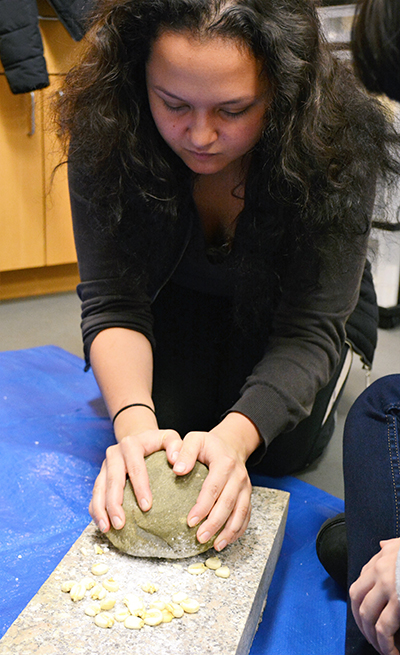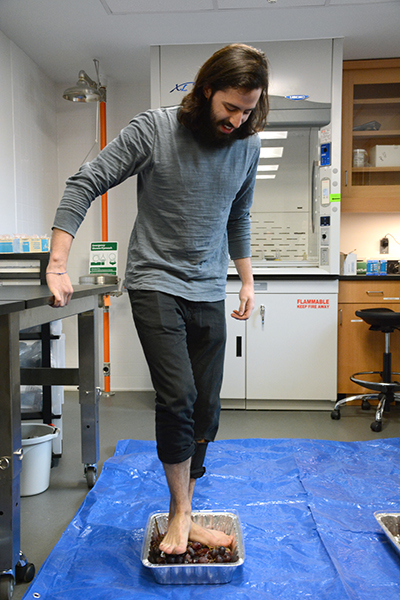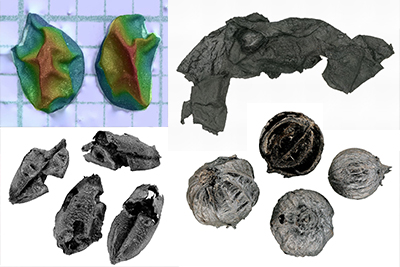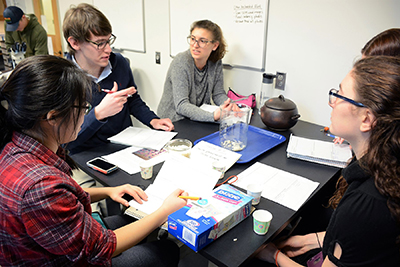Over the past academic year, a new research project has begun in the Center for the Analysis of Archaeological Materials (CAAM) that focuses on a subfield of archaeology known as archaeobotany, the study of ancient plant remains recovered from archaeological sites.


While archaeobotanical research involves a significant amount of time at the microscope identifying tiny botanical specimens, the value of archaeobotany lies in its ability to help us address much larger archaeological questions: what crops and wild plants were an important part of the human diet? What resources were available for food, building materials, and fuel? How did the local environment change over time? The remnants of plants, preserved as either macrobotanical remains (such as seeds, which can be seen with the naked eye) or microbotanical remains (which can only be identified at the cellular level), are key to understanding what human life was like in the past.
Archaeobotany provides us with a means of investigating tasks that were carried out as part of everyday routines, particularly food processing and cooking techniques. These tasks had important social, economic, and cultural meanings, and often took up a large part of people’s waking hours. Archaeobotanists have recently begun identifying the ways in which processing and cooking activities physically modify plant specimens. For example, a wheat grain that was ground using a mortar and pestle will often possess a telltale breakage pattern. By identifying this breakage pattern, archaeobotanists have been able to identify grain-grinding as early as the Neolithic period, about 10,000 years ago.
The activities associated with creating meals from scratch may be difficult to imagine for those of us today who purchase ready-to-eat foods at the grocery store. How many of us thresh, winnow, sieve, and mill our own grain? Archaeobotanists have begun to address this potential limitation through what is known as “experimental archaeobotany”—a process in which researchers carry out hands-on activities and then study the resulting assemblage of botanical remains. In ANTH 267/567 “Living World in Archaeological Science,” students have recently carried out experiments grinding maize and making chicha (a fermented maize drink), which provided them with firsthand knowledge of how these activities may have been conducted in the past. They identified starch grains from maize kernels and phytoliths from maize chaff, two types of microbotanical evidence that can be identified with the help of a high-powered microscope.
Experimental archaeobotany has become an important part of our work in CAAM, both in students’ coursework and in the creation of the Archaeobotanical Database of Foods, Herbs, and Spices. The goal of this new database is to create a reference resource that will help archaeobotanical researchers, students, and professionals identify the telltale signs of plant cooking and processing in the archaeological record. The CAAM reference collection is unique in that it contains experimental specimens in addition to modern samples of various seeds, nutshell, and other macrobotanical plant parts. Undergraduate and graduate students have been involved in creating an experimental archaeobotany collection that includes specimens such as ground cereal grain, boiled squash, fermented rice, and even pressed grape skins from winemaking. Many of our specimens have also been carbonized (burned) to recreate the preservation conditions we find at archaeological sites in contexts such as cooking hearths.
For the first phase of the database project we have chosen to focus on foods, herbs, and spices from the Mediterranean region with a special focus on ancient Greece. Penn Anthropology students Alexandria Mitchem (class of 2016) and Fabian Toro (post-baccalaureate studies 2017) traveled to Athens, Greece, this past summer to obtain plant specimens from the Wiener Laboratory at the American School of Classical Studies. These specimens along with many others are now part of CAAM’s extensive reference collection that includes nearly 900 accessions. All of the Mediterranean specimens have now been photographed using the new Keyence digital microscope, which provides a full-focused, high-quality image that is essential for identifying remains at the species level. In addition, we have been able to create 3D files that viewers can manipulate to zoom in on particular characteristics.
With the support of the Price Lab for Digital Humanities and Sasha Renninger, Digital Humanities Specialist at the Museum Library, our collection will soon be uploaded to Shared Shelf and will be accessible to online viewers through a user-friendly Omeka website. Anyone using this website will be able to compare images side by side and read detailed notes about how each specimen was processed, prepared, or cooked. In the past, reference collections were only available to those who could visit the lab in person. With CAAM’s new digital database, our reference materials will be made available to a much wider audience that might not otherwise have access to such a large experimental collection.


